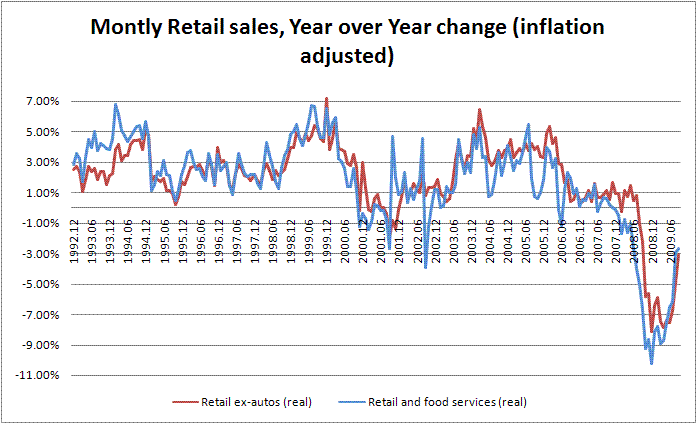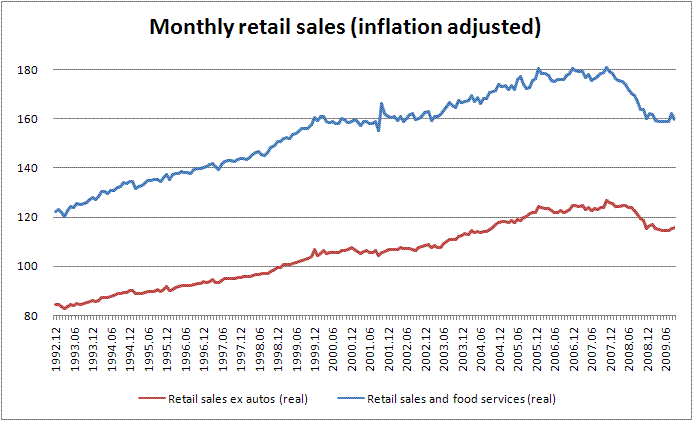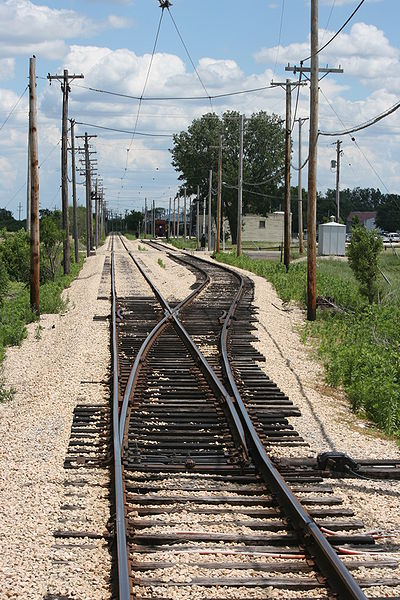
Retailers are in the business of parting consumers from their money and they have been remarkably successful at this over the past several years. However, we believe this holiday season will turn out to be very tough for most retailers as consumers will continue to maintain tight control over their spending. Consumer spending levels have been a concern since this recession started. Most observers predicted consumer spending would fall since households entered this recession with very weak balance sheets, high debt levels and low savings. Added to this weakness in household finances is the pace and extent of job losses, worse than any we have seen since 1983, with a real possibility that they may be worse than the early eighties. Consumption usually falls when unemployment rises, because people spend less when they aren’t earning. However, consumer spending has fallen further during this recession because of something called the wealth effect. When people feel less wealthy, they tend to spend less. And as home prices and investment valuations have fallen over the past couple of years, a lot of us (not just those unemployed) have begun to feel less wealthy, and as a result curtail spending.
A key portion of any recovery is the stabilization of consumer spending, and a crucial part of this spending occurs around the holidays. With this in mind, we have been looking closely at expectations and trends for retail sales over the holiday season.
A recently released ARG/UBS survey polled consumers about their anticipated spending patterns this holiday season is very revealing. They report that over 50% of survey respondents said they plan to spend less this holiday season on gifts, and most plan to buy fewer gifts for fewer people. Even children know they have to limit their expectations for Christmas gifts. ARG estimates sales will be down 2.9% when compared with 2008 (and those were down 2.7% over 2007).
We routinely look for unorthodox sources of economic data to complement traditional sources. One data source we’ve become interested in recently is Google Trends, which provides statistics on what people are searching for on Google. The Google team has made a number of different “canned queries” available and their research team published a paper earlier in the year examining how Google trends could be used as a measure of activity. What we found most intriguing were the luxury goods query statistics, which show a year over year decline of over 5%. Since Google trends measures the proportion of total queries (i.e. it accounts for the fact that the total number of queries on Google is growing) it may simply be that interest in things other than luxury goods has risen, or that more people have found the best online stores and visit them directly. However, we believe this data may augur poorly for luxury good sales this holiday season, and this view is reinforced by the ARG survey result that consumers are planning to trade down.
So, in our view the prognosis for retail sales this holiday season does not look good. Where then does that leave us? The chart below plots retail sales excluding-autos along the red line and retail sales and food services (a much broader measure) along the blue line. We adjusted for inflation to produce these charts, the nominal numbers look worse since we had some deflation in 2008/2009. The data is from the census.gov and bls.gov.

Retail sales are declining at a slower pace, but at -3.04% the rate of decline for September’s retail sales (ex autos) remains worse than any other seen over the past 15 years. The remarkable story though, is in the level of sales, which we plot below.

In real terms, the broadest measure of consumption is in the same range as it was in 2000-2002. Real retail sales excluding autos and food service are at 2004 levels. These numbers look far worse on per capita terms since the US population is growing by 2.75 million a year. What makes this picture even gloomier is that the current levels are being propped up by massive amounts of government support. Unemployment benefit periods have been extended for the longer-term unemployed, and auto-sales have been propped up with incentives. We shudder to think where consumption expenditure would be without these supports, yet at some point consumers and businesses will have to confront the reality that this government assistance cannot last indefinitely.
So where does this leave us? We believe this will be another difficult holiday season for retailers, and the medium-term picture doesn’t look any better. Consumers have cut back spending to real levels last seen 5-9 years ago, and there is no prospect of a quick rise to pre-recession consumption. We see a slow, halting recovery over 5-7 years for the following reasons:
- Unemployment is likely to remain over 6% for 5-7 years,
- Chastened consumers are saving to repair their personal balance sheets and pay down debt
- Stimulus spending will have to be withdrawn eventually
- Federal and state deficits will have to be repaired and higher taxes will eat into consumers discretionary income.
We now know that we had too many mortgage bankers, home construction workers, and investment bankers than natural growth could sustain. It may well be true that we had too many retail stores and salespeople. If retail sales do not recover for years, we will have to become accustomed to shuttered stores in many areas. Many people formerly employed in retail trade will have to look to other industries for employment. The big structural question confronting us is how US businesses are going to produce productive employment for these workers and resources. This will require retraining, and it may require the movement of labor across geographies. It will definitely take time.
 We are frequently amused by the myriad explanations pundits present for any moves in the market. Our view has always been that single day moves are largely inexplicable, and that it often takes investors time to incorporate events into their thought-process, and to translate them into action. An example is the market rose yesterday in the face of much bad economic news. The explanation from pundits was that investors were celebrating the potential victory of a Republican candidate in the Massachusetts special election to fill the senate seat left vacant after Ted Kennedy’s death. Numerous commentators noted that “gridlock in Washington is positive for wall street”. The thinking is that government action creates uncertainty, this leads to businesses spending time and resources trying to compensate for changing rules, and this slows down economic activity and lowers earnings.
We are frequently amused by the myriad explanations pundits present for any moves in the market. Our view has always been that single day moves are largely inexplicable, and that it often takes investors time to incorporate events into their thought-process, and to translate them into action. An example is the market rose yesterday in the face of much bad economic news. The explanation from pundits was that investors were celebrating the potential victory of a Republican candidate in the Massachusetts special election to fill the senate seat left vacant after Ted Kennedy’s death. Numerous commentators noted that “gridlock in Washington is positive for wall street”. The thinking is that government action creates uncertainty, this leads to businesses spending time and resources trying to compensate for changing rules, and this slows down economic activity and lowers earnings.